Articles
Re-Os geochronological constraints on the W-Mo mineralizing event in the Mount Pleasant Caldera Complex:
implications for the timing of subvolcanic magmatism and caldera development
ABSTRACT
The Mount Pleasant granite-related polymetallic deposit, located on the southwestern margin of the Late Devonian Mount Pleasant Caldera Complex in southwestern New Brunswick, contains a significant resource of tin, tungsten, molybdenum, zinc, indium, and bismuth. The Caldera Complex comprises Intracaldera, Late Caldera-Fill, and Exocaldera sequences, and associated subvolcanic granitic rocks. Three granitic intrusions (Granite I, II, and III) are recognized in the Mount Pleasant Granitic Suite in the vicinity of the Mount Pleasant deposit and are interpreted to be fractionated components of the more widespread McDougall Brook Granitic Suite. Granite I and Granite II are associated with tungsten-molybdenum and indium-bearing tin-zinc mineralization, respectively.
Despite extensive research in the Caldera Complex, the exact age of mineralization at Mount Pleasant has never been firmly established. An inferred age of < 363 Ma was based on the correlation of the dated Bailey Rock Rhyolite in the Exocaldera Sequence with that of the undated McDougall Brook Granitic Suite, which intruded the Intracaldera Sequence. New Re-Os dates of 369.7 ± 1.6 Ma and 370.1 ± 1.7 Ma obtained from molybdenite samples associated with tungsten-molybdenum mineralization at the Fire Tower Zone constrain the age of intrusion of Granite I and the initial onset of mineralization to ca. 370 ± 2 Ma (early Famennian). This is significantly older than the U-Pb age of 363 ± 2 Ma (late Famennian) previously obtained from the Bailey Rock Rhyolite in the Exocaldera Sequence. The McDougall Brook Granitic Suite, which pre-dated mineralization, must also be at least seven million years older than the Bailey Rock Rhyolite. A re-examination of the gradational relationship between the McDougall Brook Granitic Suite and purported rocks of the Bailey Rock Rhyolite in the Intracaldera Sequence suggests that the rhyolite should instead be assigned to the Seelys Formation.
Our results suggest that deposition of the tungsten-molybdenum mineralization was likely associated with caldera collapse and an early phase of resurgent doming in response to degassing of the magma chamber. This interpretation contrasts with previous models of the eruptive history at Mount Pleasant, which inferred that mineralization was coincident with the later waning stages of volcanism.
RÉSUMÉ
Un Le gisement à minéralisation polymétallique lié au granite du mont Pleasant, sur la marge sudouest du complexe caldérique du mont Pleasant, du Dévonien tardif, contient d’importantes réserves d’étain, de tungstène, de molybdène, de zinc, d’indium et de bismuth. Ce complexe caldérique situé dans le sud-ouest du Nouveau-Brunswick comprend, outre les roches granitiques subvolcaniques propres à cet environnement, des séquences d’intracaldeira et d’exocaldeira, et une séquence tardive de comblement de caldeira. On observe trois intrusions granitiques (Granite I, Granite II et Granite III) dans la suite granitique du mont Pleasant à proximité du gisement du mont Pleasant. Ces intrusions sont interprétées comme étant des fragments de la suite granitique, plus étendue, du ruisseau McDougall. Deux d’entre elles sont associées à des gisements de tungstène-molybdène (Granite I) et d’étain-zinc porteur d’indium (Granite II).
Malgré des recherches approfondies dans le complexe caldérique, il n’a jamais été possible de préciser l’âge de la minéralisation au mont Pleasant. L’âge inféré de moins de 363 millions d’années (Ma) repose sur la corrélation établie entre celui, daté, de la rhyolite du rocher Bailey, dans la séquence d’exocaldeira, et celui, non daté, de la suite granitique du ruisseau McDougall, qui recoupe la séquence d’intracaldeira. Cependant, la méthode de datation Re-Os (rhénium-osmium) permet d’estimer à entre 369,7 ± 1,6 Ma et 370,1 ± 1,7 Ma l’âge d’échantillons de molybdène associés à la minéralisation de tungstène et de molybdène de la zone Fire Tower, ce qui limiterait l’âge de l’intrusion granitique Granite I et du début de la minéralisation à environ 370 ± 2 Ma (Famennien précoce). Le site serait donc considérablement plus ancien que l’incitait à le penser la datation par U-Pb, laquelle avait permis d’en estimer l’âge, auparavant, à 363 ± 2 Ma (Famennien tardif) à partir de la rhyolite du rocher Bailey, dans la séquence d’exocaldeira. La suite granitique du ruisseau McDougall, présente avant la minéralisation, doit aussi avoir au moins sept millions d’années de plus que la rhyolite du rocher Bailey. Un réexamen de la relation évolutive entre la suite granitique du ruisseau McDougall et les roches présumées de la rhyolite du rocher Bailey, dans la séquence d’intracaldeira, semble indiquer que la rhyolite devrait plutôt être associée à la formation de Seelys.
D’après nos résultats, le dépôt de minéralisation de tungstène-molybdène était probablement lié à un effondrement caldérique et à la première phase du bombement résurgent survenu en réaction au dégazage de la chambre magmatique. Cette interprétation diffère de celle vers laquelle tendent les anciens modèles tirés de l’histoire volcanique du mont Pleasant, qui supposaient que la minéralisation coïncidait avec les dernières phases du déclin des volcans.
[Traduit par la redaction]
INTRODUCTION
1 The volcanic and subvolcanic rocks at Mount Pleasant host a polymetallic (tin, tungsten, molybdenum, zinc, indium, and bismuth) deposit that is recognized as the world’s largest known undeveloped resource of indium (Sinclair et al. 2006). This deposit consists of mineralized stockworks and quartz veinlets, breccia infill, and lode mineralization concentrated in areas of excessive fracturing, and is believed to be associated with the emplacement of granitic magma. Originally discovered in the mid-1950s, the deposit was brought into production in the mid-1980s and approximately one million tonnes of tungsten ore was extracted from the Fire Tower Zone over a two-year period by Billiton Exploration of Canada Ltd. and Brunswick Tin Mines Ltd. The mine closed in 1985 and the property mainly sat dormant for two decades. However, over the past few years, advanced exploration activity by the current owners (Adex Mining Inc.) has raised expectation that the deposit might be brought back into production in the near future. Several drill programs have redefined the resource estimates to present-day standards and metallurgical studies have been undertaken to optimize recovery from the relatively complex ore-mineral assemblage.
2 As a part of a regional study of granite-related polymetallic deposits throughout central and southwestern New Brunswick, samples were collected from the Mount Pleasant deposit for rhenium-osmium (Re-Os) isotopic analysis in order to better constrain the timing of mineralization relative to local igneous activity. Based on previous published geochronological data, the age of mineralization at Mount Pleasant could only be broadly limited to a range between the Late Devonian and Early Carboniferous (i.e., Sinclair et al. 1988; McGregor and McCutcheon 1988; Anderson 1992; McCutcheon et al. 1997; Tucker et al. 1998). The results from our Re-Os dating provides direct information on the timing of the tungstenmolybdenum mineralizing event at Mount Pleasant and highlights the need to modify previous interpretations of the magmatic-hydrothermal evolution of the Mount Pleasant Caldera Complex. This paper presents a review of the deposit geology, reports the age of the earliest mineralizing event at Mount Pleasant, and re-examines field relationships in order to resolve contradictions between these new geochronological data and previous interpretations of the stratigraphic succession and intrusive history of the Caldera Complex.
GEOLOGICAL SETTING OF THE MOUNT PLEASANT DEPOSIT
3 The Mount Pleasant polymetallic deposit is located in southwestern New Brunswick, approximately 35 km north of the Town of St. George (Fig. 1). The deposit is located near the southwestern margin of the Late Devonian Mount Pleasant Caldera Complex (McCutcheon et al. 1997), a subcircular feature that underlies an area approximately 13 km by 34 km (Fig. 2). This epicontinental caldera comprises relatively undeformed rocks of the Piskahegan Group that were emplaced in a post-collisional, trans-tensional regime following the Acadian Orogeny (Bradley 1982; Fyffe et al. 2011). These rocks overlie Ordovician and Silurian sedimentary rocks of the Cookson and Kingsclear groups to the east and west, and are in turn disconformably overlain by a sequence of Carboniferous conglomerate and sandstone to the north (Fig. 2). The Late Silurian to Late Devonian Saint George Batholith occurs just to the south of the Caldera Complex and north of the collisional boundary between the Gander and Avalon terranes of the Appalachian Orogen (Fyffe et al. 2011).
 Display large image of Figure 1
Display large image of Figure 1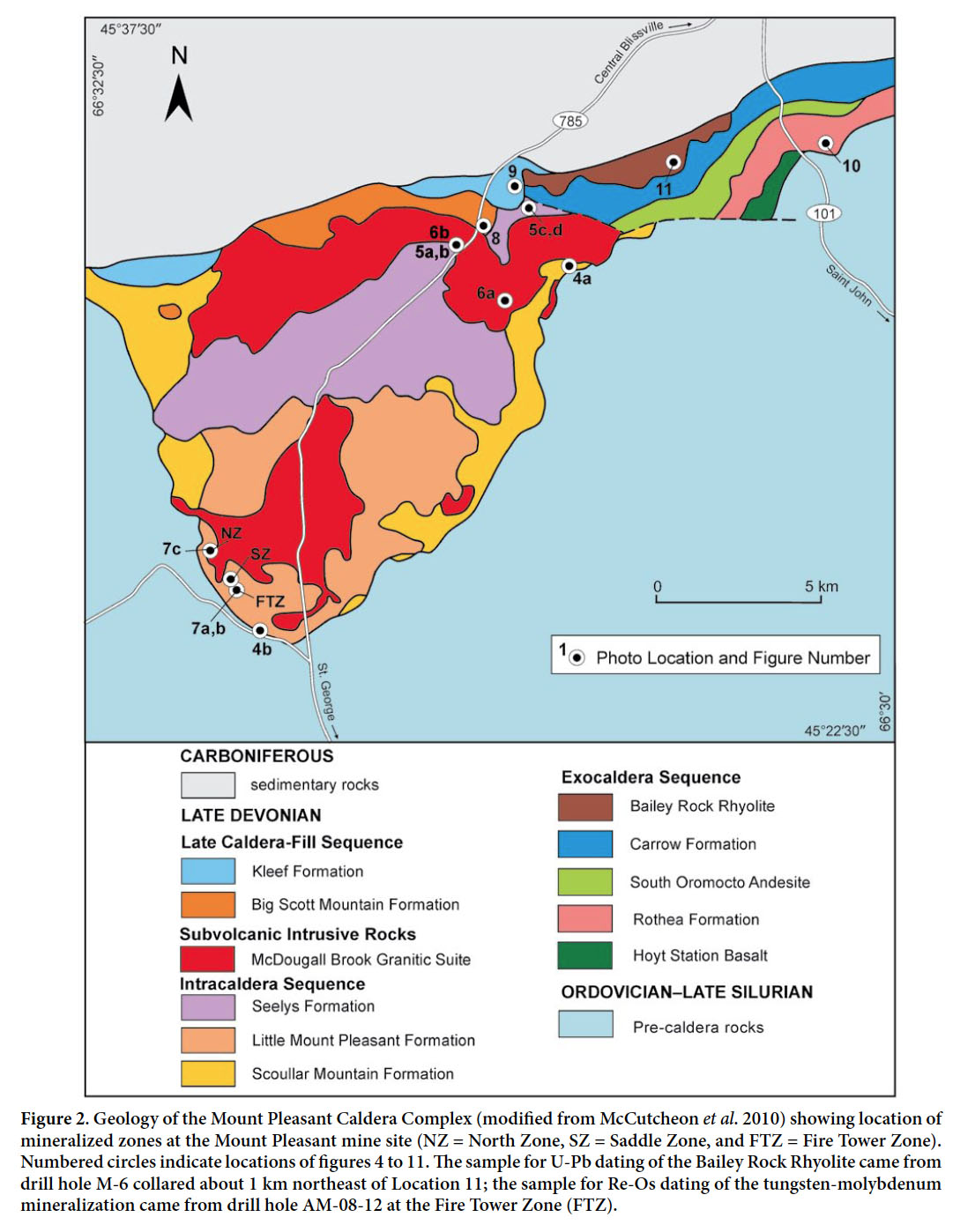 Display large image of Figure 2
Display large image of Figure 2STRATIGRAPHY OF THE MOUNT PLEASANT CALDERA COMPLEX
4 McCutcheon (1990) was the first to present a comprehensive model for the evolution of the Mount Pleasant Caldera Complex. In his model, the lithofacies of the various formations of the Piskahegan Group were used to group them into Intracaldera, Late Caldera-Fill, and Exocaldera sequences in order to reflect their depositional setting in relation to the volcanic architecture. This grouping was based on the concept of a single caldera cycle, a reasonable assumption given the limited geochronological data available at that time. We describe the formations in the Piskahegan Group under these same categories but stress that the new Re-Os ages suggest that at least two caldera-forming events occurred during the development of the Mount Pleasant Caldera Complex.
5 The stratigraphic nomenclature applied to formations comprising the Piskahegan Group has undergone considerable modification over the last fifty years as more detailed maps, new exposures, and palynological and geochronological data have become available. Nonetheless it has proven very difficult to accurately map out the distribution of felsic volcanic units in the field because of their general lack of distinctive textural characteristics. Similarly, subvolcanic plutonic rocks, which are confined to the Intracaldera Sequence, can locally be difficult to distinguish from the surrounding volcanic units (Fig. 2).
Intracaldera Sequence
6 The Intracaldera Sequence comprises, in ascending stratigraphic order, the Scoullar Mountain Formation, Little Mount Pleasant Formation, and Seelys Formation.
7 The Scoullar Mountain Formation lies along the periphery of the Mount Pleasant Caldera Complex and represents the lowest stratigraphic interval in the Intracaldera Sequence (Figs. 2, 3a, b). The term was introduced by McCutcheon (1990) to encompass the ‘Argillite Breccia’ and ‘Andesite’ units of van de Poll (1963, 1967) and Harris (1964). Angular, pebble- to boulder-sized, greyish-green sedimentary fragments derived from the surrounding Silurian strata characterize the breccia, but clasts of quartz-feldspar crystal tuff are also common (Fig. 4a). Massive to amygdaloidal, plagioclase-phyric andesite flows and beds of quartz-feldspar crystal tuff are interlayered with the breccia. The breccia is interpreted to have formed from talus shed from the ring-fracture fault scarp along the rim of the Mount Pleasant Caldera. It underlies and is intercalated with the Little Mount Pleasant Formation (Fig. 3b) described below (Harris 1964; van de Poll 1967; Sinclair et al. 1988, 2006; McCutcheon 1990; McCutcheon et al. 1997).
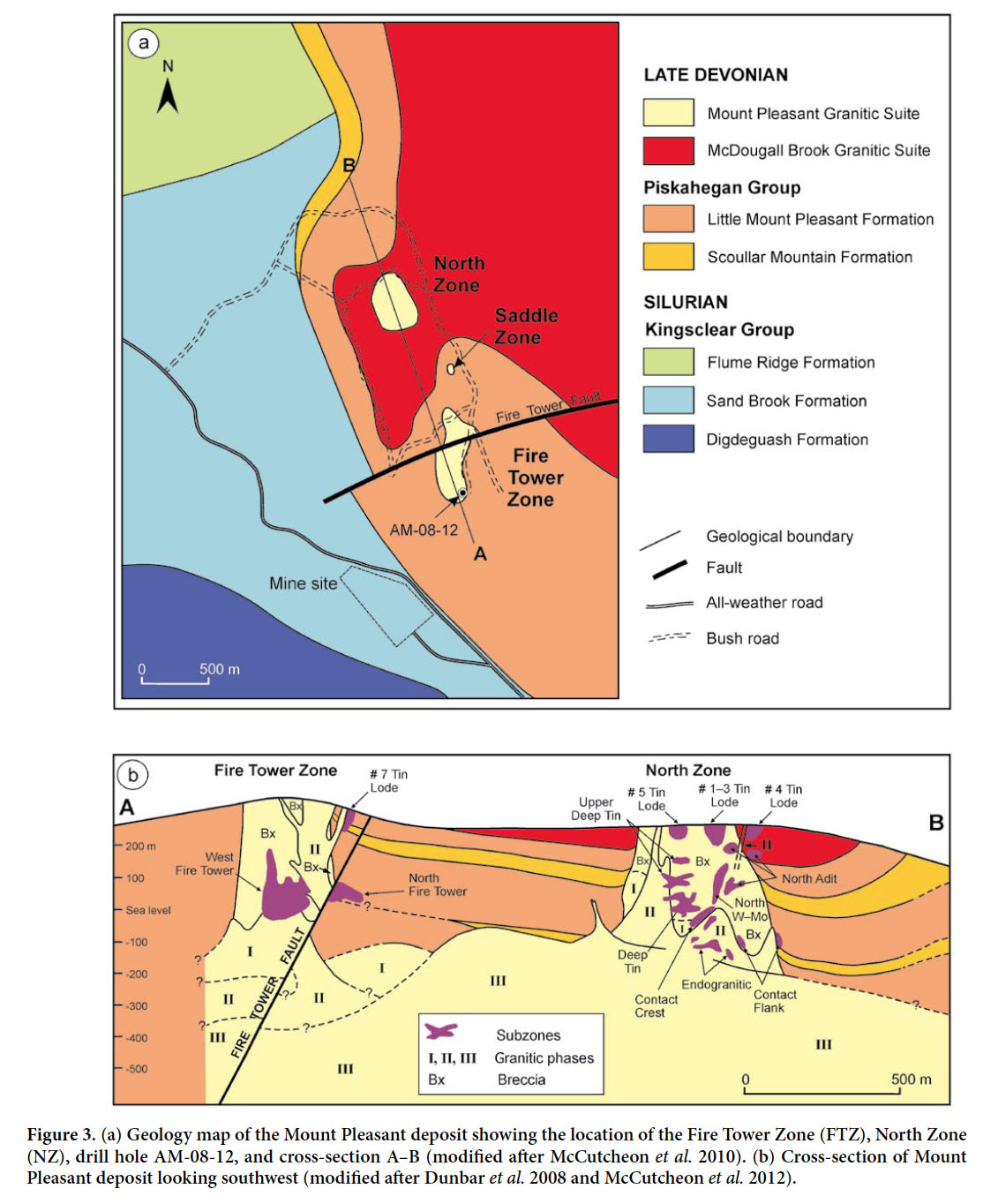 Display large image of Figure 3
Display large image of Figure 38 The Little Mount Pleasant Formation is composed primarily of pumiceous quartz-feldspar crystal tuff that underlies the southern part of the Mount Pleasant Caldera Complex (Fig. 2). These rocks were originally named the ‘Little Mount Pleasant Tuff’ by Harris (1964) but were given more rigorous formational status by McCutcheon (1990) and McCutcheon et al. (1997). Broken crystals of alkali feldspar, plagioclase, and quartz, ranging in size from 0.5 to 3.0 mm comprise 25 to 40% (all percentages by volume) of the tuff (Fig. 4b). The tuff typically contains about 5% unflattened to weakly flattened, pumice fragments that locally define a poorly developed eutaxitic foliation (Harris 1964; McCutcheon 1990).
 Display large image of Figure 4
Display large image of Figure 49 The Seelys Formation consists predominantly of strongly welded, pumiceous, lithic-crystal tuff that underlies much of the northern part of the Mount Pleasant Caldera Complex (Fig. 2). These tuffs typically contain about 5% greyish green sedimentary fragments that are generally less than 1.5 cm in length (Figs. 5a, b). Previously referred to as the ‘Seelys Porphyry’ by van de Poll (1967), the unit name was revised by McCutcheon (1990). Broken crystals of alkali feldspar, plagioclase and quartz, ranging in size from 2 to 4 mm (Fig. 5c), comprise 15 to 20% of the tuff. Highly flattened pumice fragments make up 10 to 20% of the rock (van de Poll 1967; McCutcheon 1990). Columnar joints are locally developed perpendicular to a prominent eutaxitic foliation. The generally shallow, northerly dip of this foliation (Fig. 5d) and higher topographic expression of the unit indicate that the Seelys Formation overlies the Little Mount Pleasant Formation (McCutcheon 1990). Van de Poll (1967) shows a fault separating the ‘Seelys Porphyry’ (Intracaldera Sequence) from sedimentary rocks of the Carrow Formation (Exocaldera Sequence) on the lower part of Seelys Brook (Fig. 2, Location 5c, d). However, McCutcheon (1990) interpreted the volcanic rocks at this location to belong to the Bailey Rock Rhyolite (see below) and to intrude the Carrow Formation.
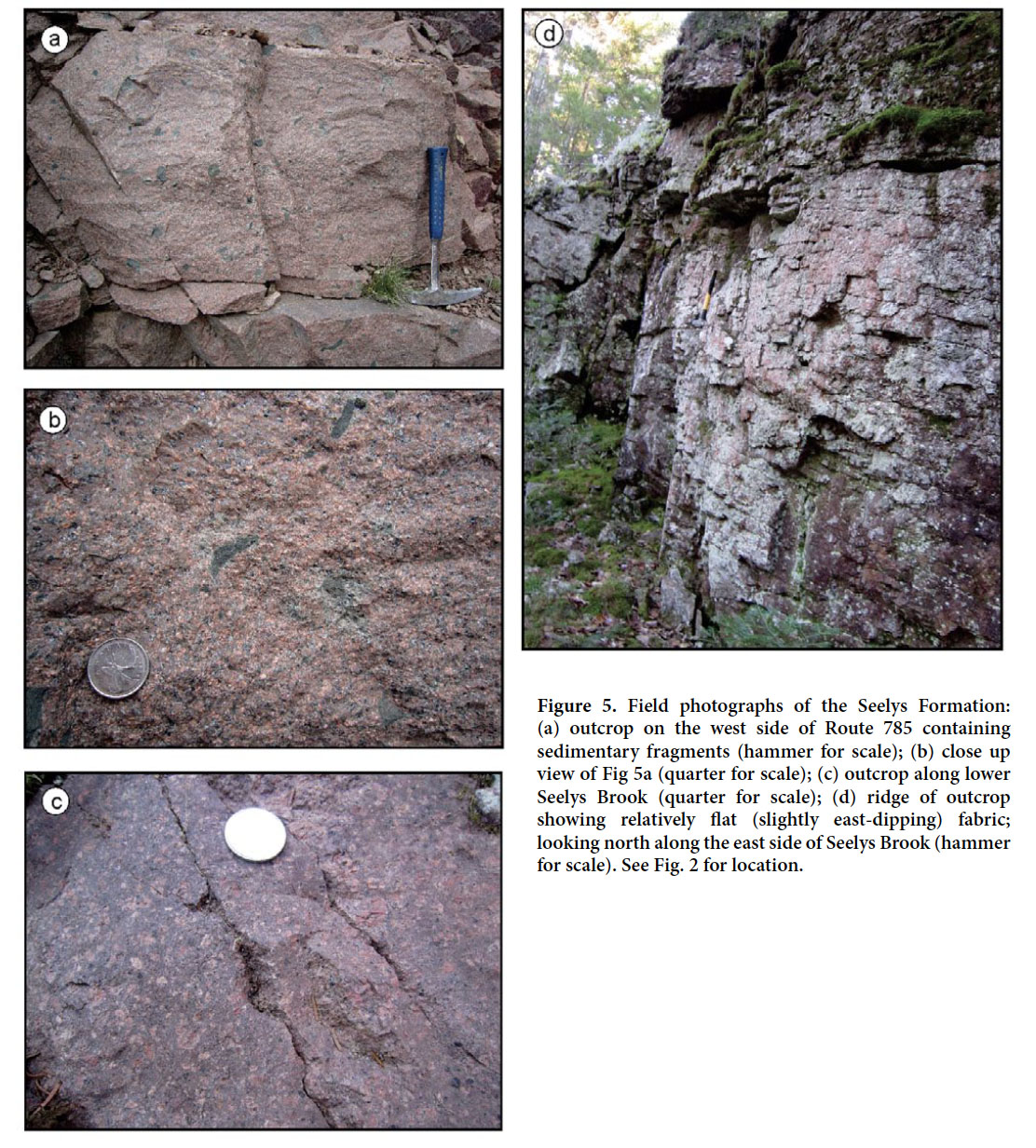 Display large image of Figure 5
Display large image of Figure 5McDougall Brook Granitic Suite
10 The McDougall Brook Granitic Suite, a term introduced by Yang et al. (2003), comprises two large subvolcanic plutons exposed over a large area within the Mount Pleasant Intracaldera Sequence; the southern pluton was emplaced into the Scoullar Mountain and Little Mount Pleasant formations, and the northern one was emplaced into the Scoullar Mountain and Seelys formations (Fig. 2). Earlier reports referred to these rocks in both the south and north as ‘latite granophyre’ (Harris 1964; van de Poll 1967). Later the term ‘McDougall Brook Granophyre’ was applied to the northern pluton (Gemmell 1975), and subsequently the term ‘McDougall Brook porphyritic microgranite’ was used to denote both plutons (McCutcheon 1990). Both plutons are composed of porphyritic microgranite that contain feldspar phenocrysts ranging in abundance from 15 to 35% and in length from 1 to 12 mm, and up to 3% clear quartz phenocrysts ranging in diameter from 1 to 4 mm (Figs. 6a, b). The groundmass varies from allotriomorphic granular to micrographic in texture and generally decreases in grain size from about 0.5 mm in the core to less than 0.1 mm near the margins of the plutons. The margins of the plutons are poorly exposed but rare dykes have been observed cross-cutting the volcanic host rocks. Hydrothermal breccias containing significant gold values occur locally in the McDougall Brook granitic rocks in proximity to the contact with volcanic rocks of the Seelys Formation (McCutcheon 1990; Yang et al. 2003).
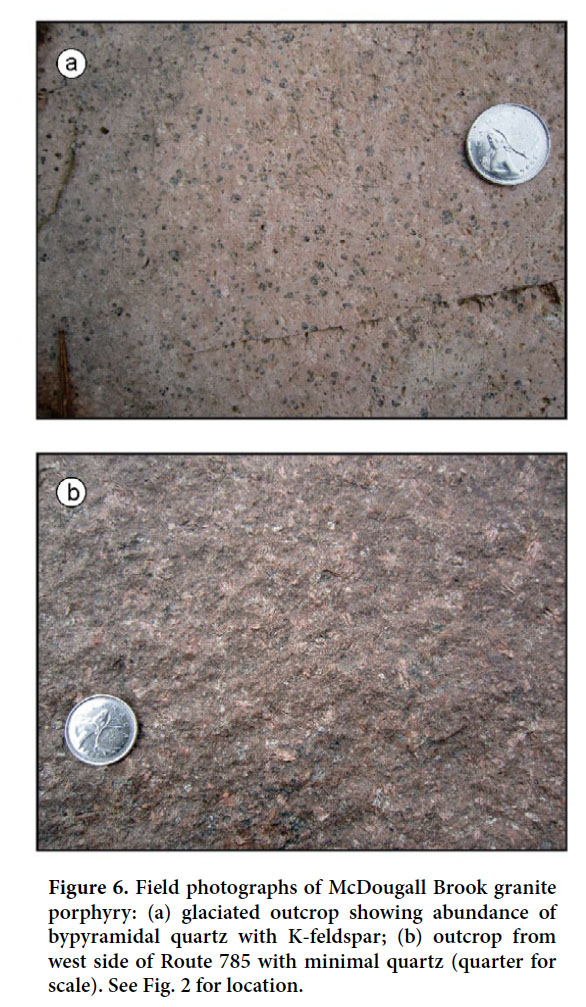 Display large image of Figure 6
Display large image of Figure 6Mount Pleasant Granitic Suite
11 The Mount Pleasant Granitic Suite as defined by Yang et al. (2003) includes granitic dykes, small plug-like bodies, and hydrothermal breccias exposed at surface and at shallow depths; and coarser grained subvolcanic rocks intersected in deep drill holes (Granite I, II, and III; Figs 3a, b). The suite was emplaced along the western margin of the Intracaldera Sequence of the Mount Pleasant Caldera Complex (Fig. 2), where it is associated with two main polymetallic deposits (North and Fire Tower zones) at Mount Pleasant (Figs. 3a, b). The dykes commonly exhibit flow-layering, and cross-cutting relationships that indicate multiple stages of dyke emplacement.
12 The surface intrusive rocks were originally termed the ‘Mount Pleasant porphyry’ by Atkinson et al. (1981). McCutcheon (1990) and McCutcheon et al. (1997) included the ‘Mount Pleasant porphyry’ in the Late Caldera-Fill Sequence of the Mount Pleasant Caldera Complex but in light of our new age data, we treat the Mount Pleasant Granitic Suite separately from the volcanic stratigraphy. A historical summary of the observations that has led to the present understanding of the intrusive relationships and associated mineralization events within the Mount Pleasant Caldera Complex is given below.
13 The polymetallic mineral deposits at Mount Pleasant have been described in several papers over a period of some fifty years but until recently little data were available to document either the absolute timing of granite emplacement or the age of the associated mineralization. The mineralization at Mount Pleasant was recognized to be genetically related to granites soon after its discovery, when Black (1961) reported that mineralization is associated with pipe-like bodies of explosion breccia along the southwestern margin of a supposed Mississippian volcanic complex. Hosking (1963) subsequently documented the presence of fine-grained granite porphyry dykes cutting the breccia and postulated that the volcanic complex is underlain at depth by a co-magmatic pluton, based on an intersection of granite in a deep drill hole.
14 Mapping by Ruitenberg (1967) indicated that the breccia pipe associated with the Fire Tower Zone was emplaced into a pyroclastic volcanic sequence (equivalent to the Little Mount Pleasant tuff of Harris (1964)), whereas the breccia pipe associated with the North Zone was emplaced into a coarser grained feldspar porphyry (Figs. 3a, b). Ruitenberg (1967), McCutcheon (1990), and McCutcheon et al. (1997) considered this pre-mineralization feldspar porphyry to be intrusive and contiguous with the southern pluton of the McDougall Brook microgranite (equivalent to the latite granophyre of Harris (1964)). On the other hand Sinclair et al. (1988, 2006) and Inverno and Hutchinson (2006) suggested that the feldspar porphyry is a massive lava flow based on its sub-horizontal contact with the Little Mount Pleasant tuff.
15 Dagger (1972) described the presence of two types of mineralization at Mount Pleasant: tungsten-molybdenum concentrated in the Fire Tower Zone and tin-zinc concentrated in the North Zone. He made the important observation that all granitic dykes carry disseminated sphalerite, but some of them cut molybdenite-bearing veinlets, suggesting that the tin-zinc mineralization is younger than the tungsten-molybdenum mineralization. However, he concluded somewhat paradoxically that the two mineralizing events were essentially contemporaneous. Atkinson et al. (1981), who referred to the dykes cross-cutting the mineralized breccia collectively as the ‘Mount Pleasant porphyry’, observed that some of the dykes exhibit flow-banding and locally developed into pebble dykes containing well-rounded volcanic fragments.
16 Kooiman et al. (1986) presented convincing evidence for the relationship between the distinct mineralizing events and two episodes of dyke emplacement at Mount Pleasant. They showed that the breccia pipe in the Fire Tower Zone grades at depth into irregular bodies and dykes of fine-grained equigranular granite that are clearly cross-cut by a second set of finer grained granite porphyry dykes with flow-banded contacts. At surface the breccia pipe contains many fragments of Little Mount Pleasant tuff but at depth, fragments of fine-grained granite are abundant and then pass into unbrecciated granite. The tungstenmolybdenum mineralization in the Fire Tower Zone post-dated the fine-grained, equigranular granite but pre-dated the granite porphyry dykes. The porphyry dykes were shown to be associated with the tin-zinc mineralization and to apparently grade downward into medium-grained, equigranular to porphyritic granite encountered in the previously mentioned deep drill hole.
17 Sinclair et al. (1988) documented a similar magmatic history for the North Zone at Mount Pleasant referring to the intrusive intervals there as Granite I, II, and III. The early fine-grained, equigranular granite associated with the tungsten-molybdenum mineralization in the Fire Tower Zone was correlated with their Granite I in the North Zone. Granite I occurs as irregular granitic bodies that progressively grade into hydrothermal breccias (Figs. 3a, b), which contain silicified and chloritized fragments of Granite I. The later finer grained granite porphyry dykes associated with the tin-zinc lodes at the Fire Tower Zone were correlated with Granite II at depth in the North Zone. Granite II contains abundant miarolitic cavities and comb quartz layers (Fig. 7) and is the source of a number of separate tin deposits distributed over a wide depth range in the North Zone. Tin lodes near and at surface in the North Zone are associated with banded granite porphyry dykes that are interpreted as offshoots of Granite II. The Upper Deep, Deep Tin, Contact Crest and Contact Flank deposits are hosted by breccia and Granite II between depths of 200– 400 m whereas the Endogranitic deposit is hosted by Granite II at a depth of about 500 m. Granite III (referred to as the “porphyritic granite” at the Fire Tower Zone) underlies the other two granites and comprises fine- to medium-grained equigranular porphyritic and pegmatitic granite (Fig. 3b). Granite III is generally less fractured than Granite I and II (Fig. 7c). The contact between Granite III and Granite II is commonly sharp in the North Zone (Sinclair et al. 1988) and marked by thin layers of unidirectional solidification textures (cf. Kirkham and Sinclair 1988) in Granite III (Fig. 7d). However, in the Fire Tower Zone, Granite III grades into Granite II (Kooiman et al. 1986); to date, only minor isolated tin occurrences have been found in Granite III. Herein we follow the suggestion of Sinclair et al. 2006 and apply the terms Granite I, II, and III to the intrusive units at both zones (Fig. 3).
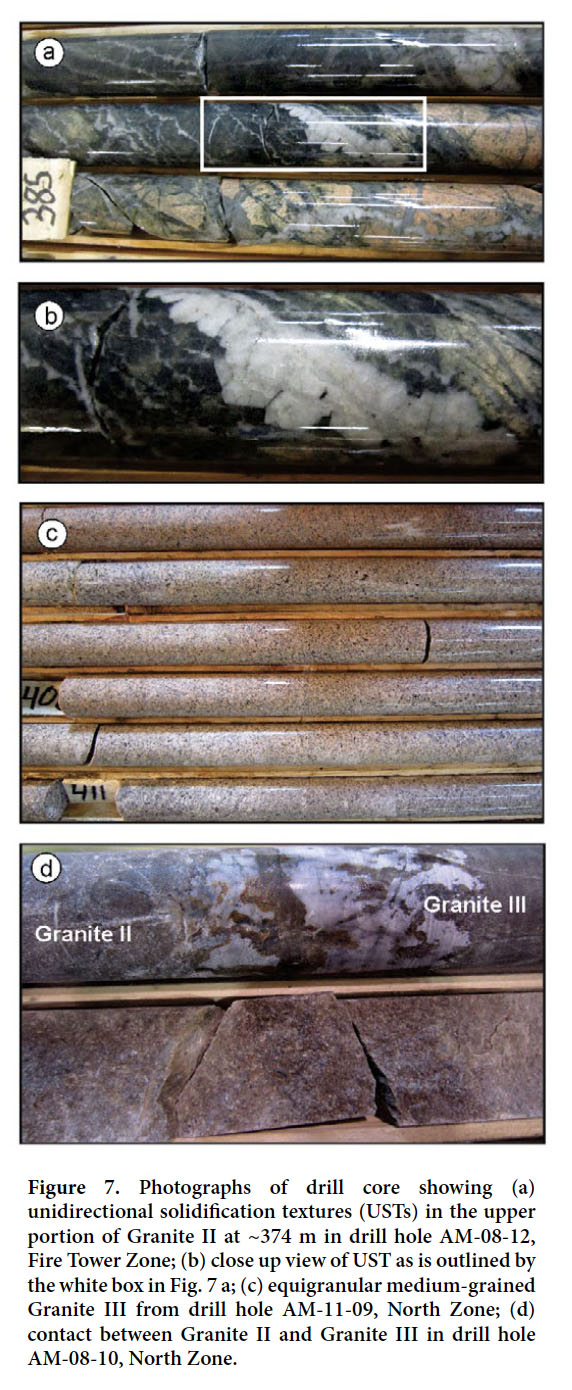 Display large image of Figure 7
Display large image of Figure 718 Sinclair et al. (2006) commented on the profound change in composition of the mineralizing fluids that occurred during the hiatus between the emplacement of Granite I and II. They suggested that the two distinct types of mineralization were deposited from magmatichydrothermal fluids derived from a large body of convecting silica-rich magma now represented by the granite pluton (Granite III) underlying the Mount Pleasant volcanic complex. The fluids were degassed in two stages through subvolcanic cupolas (Granite I and II) at the top of the magma chamber. It was suggested that the differences in the two episodes of mineralization may be related to a combination of decreasing temperature, reduction of the magma as a consequence of degassing, and melt fractionation (Sinclair et al. 2006). In contrast, Inverno and Hutchinson (2004) attributed the tin-zinc mineralization to late-stage differentiation of a largely consolidated Granite III pluton.
19 Petrochemical modelling of magmatic evolution of the Mount Pleasant Caldera Complex (Yang et al. 2003) suggested a direct link between the highly evolved rocks (Granites I, II, III) of the Mount Pleasant Granitic Suite and the less differentiated rocks that comprise the McDougall Brook Granitic Suite. All of the intrusions are interpreted to have originated from the same parent magma through fractional crystallization and crustal contamination. Subsequent compositional changes were likely controlled by extensive fluid fractionation within the Mount Pleasant Granitic Suite.
Late Caldera-Fill Sequence
20 The Late Caldera-Fill Sequence of McCutcheon (1990) comprises the Big Scott Mountain and Kleef formations (Fig. 2). Although the age of this sequence is not firmly established, it is most likely Late Devonian as it is unconformably overlain by Mississippian redbeds at the base of the Carboniferous sedimentary succession (Fig. 2).
21 The Big Scott Mountain Formation, a term introduced by Gemmell (1975), consists of porphyritic to nearly aphyric, flow-banded rhyolite (Fig. 8a), and less abundant lithic tuff. The porphyritic rhyolite flows contain between 15 to 30% phenocrysts of quartz and feldspar ranging from 1 to 6 mm in size; spherulitic textures and flow folds are characteristic of the unit. Lithic tuffs intercalated within the Big Scott Mountain Formation contain boulder-sized clasts that resemble the Seelys Formation and McDougall Brook microgranite of the underlying Intracaldera Sequence (McCutcheon 1990).
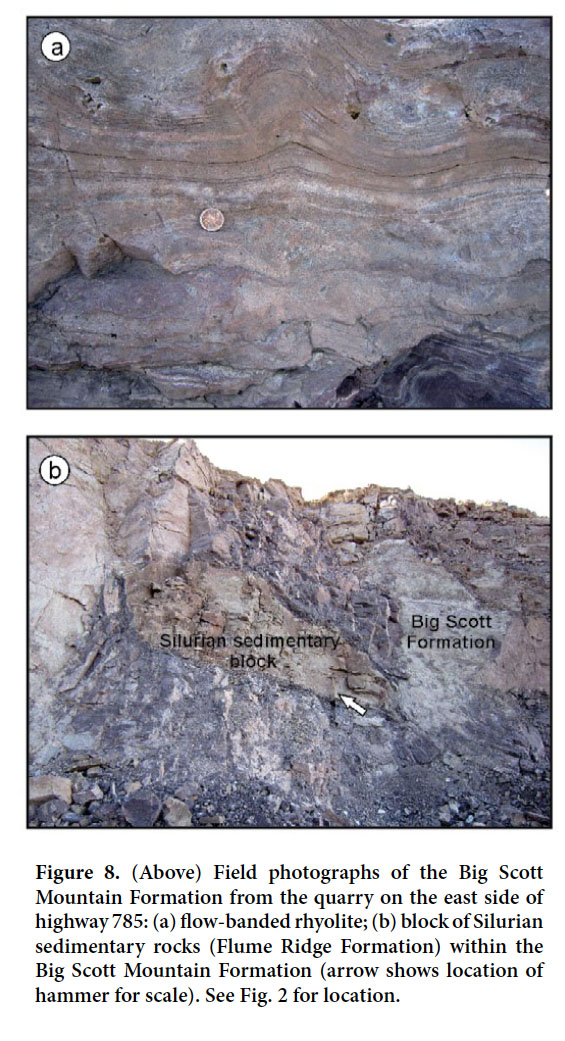 Display large image of Figure 8
Display large image of Figure 822 A large sedimentary block likely derived from underlying Silurian strata has been incorporated into a sequence of Big Scott Mountain lava flows recently exposed in a quarry (Fig. 8b). The presence of this block suggests that a major episode of caldera collapse was occurring at the time so that the previous categorization of the Big Scott Mountain Formation as part of a Late Caldera-Fill Sequence needs to be re-assessed.
23 The Kleef Formation, a term formally introduced by van de Poll (1967), is dominantly coarse-grained redbeds intercalated with basalt flows and lithic tuff. Pebble to cobble conglomerate contains large volcanic clasts (Fig. 9a), most of which were derived from the massive Seelys (Fig. 9b) and flow-banded Big Scott Mountain (Fig. 9c) formations. The basalt flows vary from aphyric to porphyritic with up to 15% plagioclase phenocrysts ranging from 0.2 to 1.0 mm in length. Amygdules up to 1 cm in diameter are abundant near the top of the flows and are filled with silica and rimmed by hematite. The lithic tuff contains up to 15% flattened pumice fragments up to 3 cm in length that define a well-developed eutaxitic foliation; felsic volcanic clasts (typically about 1 cm in diameter) compose from 5 to 25% of the rock (McCutcheon 1990). The contact between the Kleef and Big Scott Mountain formations is not exposed; however the presence of blocks of Big Scott Mountain rhyolite in the Kleef conglomerate (Fig. 9c) suggests that the Kleef Formation represents the topmost unit of the Piskahegan Group.
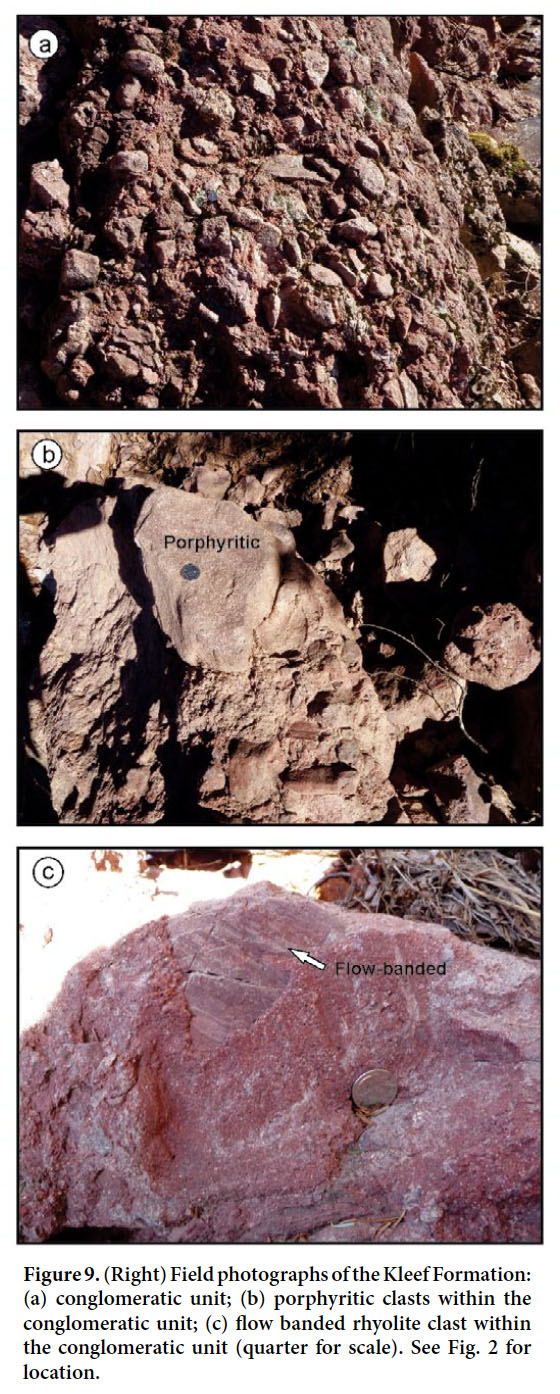 Display large image of Figure 9
Display large image of Figure 9Exocaldera Sequence
24 The Exocaldera Sequence consists, in ascending stratigraphic order, of the Hoyt Station Basalt, Rothea Formation, South Oromocto Andesite, Carrow Formation, and Bailey Rock Rhyolite.
25 The Hoyt Station Basalt was a name applied by McCutcheon (1990) to the basal unit of the Piskahegan Group within the Exocaldera Sequence. It comprises massive to amygdaloidal basalt and aphyric to plagioclase-phyric basalt underlain by greyish-red rhyolitic crystal tuff and pale red lithic tuff, and minor reddish polymictic pebble- to boulder-conglomerate (McCutcheon 1990; McCutcheon et al. 1997). McCutcheon (1990) interpreted the contact with Silurian sandstone of the Flume Ridge Formation to the south as an unconformity but truncation of the basalt unit along strike to the southwest suggests that the boundary is a fault (Fig. 2).
26 The Rothea Formation comprises unwelded, pumiceous lapilli tuff, quartz-feldspar crystal tuff (Fig. 10), aphyric tuff, and overlying reddish brown mudstone and lithic tuff. This sequence of mainly ash-flow tuffs was originally referred to as the ‘Rothea Porphyry’ by van de Poll (1967). Contacts with the underlying Hoyt Station Basalt and overlying South Oromocto Andesite are not exposed but are assumed to be conformable or disconformable (McCutcheon 1990; McCutcheon et al. 1997).
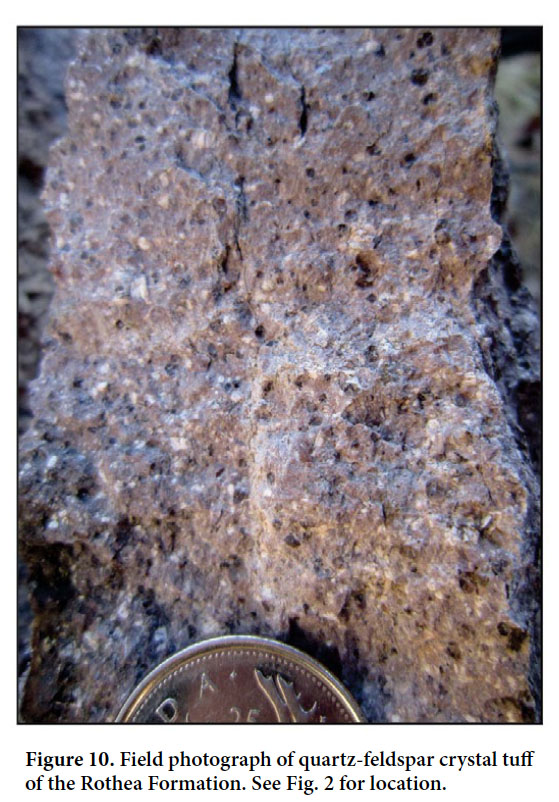 Display large image of Figure 10
Display large image of Figure 1027 The South Oromocto Andesite is composed of plagioclase phyric and amygdaloidal andesite flows, and brecciated andesite (McCutcheon 1990). Originally termed the ‘South Oromocto Basalt’ by van de Poll (1967), the name was changed to reflect its composition as a basaltic andesite (Fyffe and Barr 1986; McCutcheon 1990). Upper and lower contacts are not exposed at surface but a drill-core section suggests a conformable relationship with mudstones of both the underlying Rothea Formation and overlying Carrow Formation (McCutcheon 1990).
28 The Carrow Formation grades up-section from predominantly greyish-green pebble to cobble conglomerate (with abundant locally derived felsic volcanic clasts) and sandstone into greyish-red mudstone with intercalated calcrete (van de Poll 1967; McCutcheon 1990). An unwelded pumiceous lapilli tuff occurs in the lower part of the section and a basalt flow occurs in the upper part. A spore assemblage recovered from drill core in the upper part of the Carrow Formation yielded a Late Famennian age (McGregor and McCutcheon 1988). A U-Pb date on zircon from the pumiceous tuff in drill core about 120 m beneath the spore locality yielded an age of 363.8 ± 2.2 Ma (Tucker et al. 1998).
29 The Bailey Rock Rhyolite is a flow-banded, felsic volcanic rock containing 5 to 10% quartz crystals ranging in diameter from 0.1 to 2 mm, and 20 to 25 % feldspar crystals ranging in length from 1 to 8 mm (Fig. 11). Van de Poll (1967) had originally mapped the type area of the Bailey Rock Rhyolite, located along the northern flank of the Mount Pleasant Caldera Complex, to be part of his ‘Seelys Porphyry’. However, both Gemmell (1975) and McCutcheon (1990) considered the flow-banded Bailey Rock unit to be distinct from the more highly welded ‘Seelys Porphyry’ of the Intracaldera Sequence. Originally termed the ‘Bailey Rock Formation’ and considered to be ash-flow tuffs by Gemmell (1975), McCutcheon (1990) interpreted these rocks to be rhyolitic lava flows based on the absence of angular crystal fragments and pumice pseudomorphs. Drill core from its type area indicates that the Bailey Rock Rhyolite conformably overlies sedimentary rocks of the Carrow Formation and hence represents the youngest part of the Exocaldera Sequence. Its contact with overlying conglomerate of the Kleef Formation (Late Caldera-Fill Sequence) can be approached to within a few metres and appears to be concordant.
 Display large image of Figure 11
Display large image of Figure 1130 A sample of Bailey Rock Rhyolite from drill core yielded a U-Pb date on zircon of 363.4 ± 1.8 Ma (Tucker et al. 1998), consistent with its stratigraphic position above the spore-bearing late Famennian Carrow Formation (McGregor and McCutcheon 1988).
MINERAL DEPOSITS AT MOUNT PLEASANT
31 The Mount Pleasant polymetallic deposits are associated with hydrothermal breccias and subvolcanic intrusive rocks (the Mount Pleasant Granitic Suite) that cut the Intracaldera Sequence. The mineralization occurs in two main zones (North and Fire Tower zones) that are located approximately 1 km apart with a smaller third zone (Saddle Zone) located halfway in between (Figs. 2, 3a). The Fire Tower Zone consists predominantly of tungsten-molybdenum mineralization, which is cross-cut by minor tin and zinc lodes; the mineralization is concentrated in two subzones termed FTZ West and FTZ North (Fig. 3b). The North Zone consists predominantly of indium-bearing tin-zinc mineralization with lesser earlier tungsten-molybdenum mineralization; subzones include the Upper Deep, Deep Tin, Contact Crest, Contact Flank, and Endogranitic (Fig. 3b). The Saddle Zone consists of tin mineralization underlying a topographically depressed area between the North and Fire Tower zones.
32 The total NI 43-101 resource estimate for the Fire Tower Zone presently includes an indicated resource of 13,489,000 tonnes at 0.33% WO 3 and 0.21% MoS 2 and an inferred resource of 841,700 tonnes at 0.26% WO 3 and 0.20% MoS 2 (Dunbar et al. 2008). At the North Zone, the NI 43-101 resource estimate consists of 12,400,000 indicated tonnes averaging 0.38% Sn, 0.86% Zn, and 64 ppm In, as well as an inferred resource of 2,800,000 tonnes averaging 0.30% Sn, 1.13% Zn, and 70 ppm In (McCutcheon et al. 2012).
Fire Tower Zone
33 At the Fire Tower Zone, wolframite and molybdenite are the most abundant ore minerals and are accompanied by minor native bismuth and bismuthinite. The tungstenmolybdenum mineralization occurs primarily as disseminations within breccia pipes and in stockworks and veinlets within the upper part of a fine-grained granite intrusion (Granite I) and volcanic host rocks of the Little Mount Pleasant Formation. The host rocks have been pervasively greisenized to an assemblage of quartz, topaz, and fluorite.
34 A comprehensive paragenetic study of the Fire Tower Zone undertaken by Petruk (1973) identified three main mineral assemblages (in order of deposition): (1) chlorite, topaz, fluorite, septechlorite, kaolinite, hydromica, hematite, quartz, serpentine, molybdenite, wolframite, rutile, cassiterite, rare-earth phosphates (monazite and Yb + Er-bearing phosphate), zircon, tourmaline and loellingite; (2) fluorite, serpentine, molybdenite, wolframite, rutile, cassiterite, tourmaline, loellingite, arsenopyrite, native bismuth, kaolinite, and quartz; and (3) fluorite, serpentine, wolframite, molybdenite, tourmaline, arsenopyrite, septechlorite, quartz, rutile, cassiterite, pyrite, sphalerite, stannite, chalcopyrite, kesterite, stannoidite, mawsonite, roquesite, bornite, galena, bismuthinite, wittichenite, aikinite, galenobismutite, cosalite, native silver, marcasite, tennantite, and siderite.
35 The first two assemblages account for the bulk of the tungsten, molybdenum, and bismuth mineralization and the third accounts for the tin, zinc, and indium mineralization. Minor molybdenite along fractures within the fine-grained granite underlying the main mineralized zone at depth is thought to represent the latest mineralization related to tungsten-molybdenum deposition during final crystallization of Granite I (Kooiman et al. 1986; Sinclair et al. 2006). The indium-bearing, tin-zinc mineralization is irregularly distributed in cross-cutting veins and breccias throughout the Fire Tower Zone and is generally associated with altered granite porphyry dikes of Granite II (Sinclair et al. 2006). Cassiterite and wolframite are present as tiny disseminated grains with local aggregates of wolframite up to several centimetres long. Variable proportions of base-metal sulphides associated with the tin lodes consist mainly of indium-rich sphalerite, chalcopyrite, and galena.
36 Fluid inclusion studies conducted by Samson (1990) on samples collected from the Fire Tower Zone revealed that the early stages of mineralization (tungsten-molybdenum) were associated with three fluid inclusion types that include: low-salinity liquid-vapor inclusions (type I), vapor-rich inclusions (type II), and high-salinity liquid-vapor-solid inclusions (type III). Minerals comprising the second stage of mineralization (tin and base-metals) only had type I inclusions. The variation in inclusion types associated with the tungsten-molybdenum mineralization was explained to be a result of adiabatic cooling of the Granite I-related orthomagmatic fluids released into the country rocks after overpressurization within the magma chamber, and subsequent mixing with groundwater. Fluids from which the tungsten-molybdenum mineralization was derived were found to have high salinities (30–60 equivalent wt. % NaCl). After the second influx of orthomagmatic fluids associated with the emplacement of Granite II, tin and base-metal mineralization was precipitated from lowsalinity (<10 equivalent wt. % NaCl + CaCl2 ) aqueous fluids (groundwater) that permeated the apical portions of the pluton.
North Zone
37 The North Zone consists of breccia- and stockwork-hosted tungsten-molybdenum mineralization similar to that associated with Granite I at the Fire Tower Zone. However, these zones of tungsten-molybdenum mineralization are discontinuous, smaller in size and of less significance than the tin-zinc lodes that overprint them. Several distinct tinindium-bearing subzones are recognized within the North Zone associated with banded dykes of Granite II (Fig. 3b). Ore minerals include fine-grained cassiterite, arsenopyrite, loellingite, indium-bearing sphalerite, and chalcopyrite with lesser amounts of stannite, pyrite, marcasite, galena, wolframite, molybdenite, tennantite, chalcocite, bornite, native bismuth, bismuthinite, and wittichenite (Sinclair et al. 2006). These minerals occur in veins and veinlets, infilling the matrix of breccias, filling vugs, and as disseminated grains and clusters of grains replacing altered host rocks. Fluorite and chlorite are the common gangue minerals associated with the sulphides whereas the associated greisen-type alteration assemblage comprises quartz, sericite, topaz, and fluorite (Sinclair et al. 2006).
AGE OF MINERALIZATION AT MOUNT PLEASANT
38 The age of the Mount Pleasant mineralizing system has been previously inferred by dating of selected rock units within the Mount Pleasant Caldera Complex. A 40Ar/39Ar date of ca. 360 Ma indicated that the granites associated with the mineralization may have been emplaced during Late Devonian – Early Mississippian time (Sinclair et al. 1988). Whole-rock K-Ar dating of two samples from biotite-rich, hydrothermally altered granite porphyry (Granite II) yielded much younger ages of 339 ± 10 and 334 ± 7 Ma (Kooiman et al. 1986). A whole-rock Rb-Sr date was also obtained on quartz-feldspar porphyry, fine-grained granite, granite porphyry, and porphyritic granite, which yielded an errorchron of 332 ± 12 Ma (Kooiman et al. 1986). By omitting one of the anomalous samples, Kooiman et al. (1986) produced a revised errorchron that was slightly younger (328 ± 4 Ma). A Late Devonian whole-rock Rb-Sr date of 368 ± 5 Ma was obtained from a six-point isochron that included samples from the Scoullar Mountain and Little Mount Pleasant formations, and McDougall Brook microgranite (Anderson 1992). This age is essentially the same as the U-Pb age of 367± 1 Ma from the Mount Douglas Granite, the youngest component of the Saint George Batholith (Bevier 1988). A whole-rock K-Ar date of 361 ± 9 Ma was obtained from biotite-bearing, hornfelsed sedimentary breccia 1 km north-northwest of the Fire Tower Zone (Hunt and Roddick 1990), which is consistent with a Late Devonian to Early Mississippian cooling age for the subvolcanic intrusions at Mount Pleasant.
39 The spore and U-Pb ages from the Bailey Rock Rhyolite of the Exocaldera Sequence were used to infer that the mineralization at Mount Pleasant is no older than 363.4 ± 1.8 Ma (McGregor and McCutcheon 1988; Tucker et al. 1998). This inference is based on the interpretation that the McDougall Brook Granitic Suite, which predates the mineralizing events, grades into a supposed intrusive equivalent of the Bailey Rock Rhyolite within the Intracaldera Sequence (McCutcheon 1990; McCutcheon et al. 1997). Specifically, it is the southern pluton of the McDougall Brook Granitic Suite that is known to pre-date the mineralization in the North Zone, and it is the northern pluton that has been interpreted to grade into the Bailey Rock Rhyolite.
Methodology
40 The Re-Os geochronometer can help to constrain genetic deposit models as it provides a reliable method to directly date a number of mineralized systems, including those that have been variably deformed and metamorphosed (Stein et al. 1997, 1998; Selby et al. 2003). Rhenium and osmium are commonly substituted into the sulphide structure because they are chalcophile-siderophile elements. Although this method of dating can be used on several sulphide minerals (i.e., pyrite, arsenopyrite, chalcopyrite, pyrrhotite), it is most commonly applied to molybdenite as Re tends to substitute for Mo and there is no initial (common) Os in the molybdenite. Therefore, all of the Os measured is generated from the decay of 187Re, and the precise isotopic age of the molybdenite can be determined using the measurement of Re and Os concentrations within the molybdenite combined with the decay constant of 187Re.
Analytical procedures
41 Two samples of molybdenite were collected from drill hole AM-08-12 (Fig. 3a) to determine the age of the mineralization that is associated with Granite I. This drill hole intersected tungsten-molybdenum mineralization in the southern portion of the FTZ West. The core consists of alternating units of altered Granite I and breccia that contains abundant purple and green fluorite with minor molybdenite, arsenopyrite, and wolframite mineralization. Sample KT-11-06 was collected from the interval between 279.25 m and 279.35 m; it contains coarse-grained molybdenite (“network-textured”) hosted within a 5 cm-wide quartz vein cutting chloritized breccia of Granite I (Fig. 12a). Sample KT-11-08 was collected from the interval between 339.80 m and 339.85 m; it contains patches of fine-grained molybdenite hosted within stockwork veins cutting chloritized Granite I (Fig. 12b).
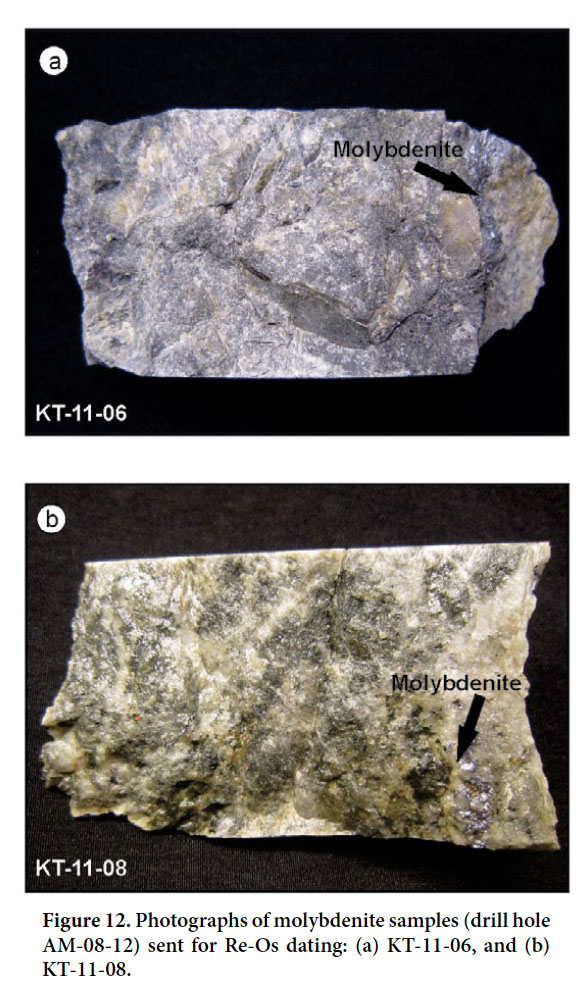 Display large image of Figure 12
Display large image of Figure 1242 Each sample was subjected to metal-free crushing after which the molybdenite was separated out by gravity and magnetic concentration methods. Methods used to analyze the molybdenite are described in detail by Selby and Creaser (2004) and Markey et al. (2007). The 187Re and 187Os concentrations in molybdenite were determined at the University of Alberta Radiogenic Isotope Facility by isotope dilution mass spectrometry using Carius-tube digestion, solvent extraction, anion exchange chromatography, and negative thermal ionization mass spectrometry techniques. A mixed double spike containing known amounts of isotopically enriched 185Re, 190Os, and 188Os analysis was used. Isotopic analysis used a ThermoScientific Triton mass spectrometer with a Faraday collector. Total procedural blanks for Re and Os are less than 3 picograms and 2 picograms, respectively, which are insignificant for the Re and Os concentrations in molybdenite. The Chinese molybdenite powder HLP-5 (Markey et al. 1998), is routinely analyzed as a Re-Os age standard. For this sample over a period of two years, an average Re-Os date of 221.5 ± 0.4 Ma (1SD uncertainty, n=8) is obtained. This Re-Os age date is indistinguishable from that reported by Markey et al. (1998) of 221.0 ± 1.0 Ma.
Results
43 Results of the Re-Os analysis of the two samples are given in Table 1. The age uncertainty is quoted at 2σ level, and includes all known analytical uncertainties, including uncertainty in the decay constant of 187Re. The molybdenite in samples KT-11-06 and KT-11-08 yielded essentially identical Re-Os model ages of 370.1 ±1.7 Ma of 369.7 ± 1.6 Ma, respectively. The Re-Os molybdenite ages establish the time of deposition of tungsten-molybdenum mineralization at Mount Pleasant as ca. 370 ± 2 Ma (early Famennian). This age is older than the inferred age for mineralization based on previous results obtained from the Bailey Rock Rhyolite (Tucker et al. 1998).
44 Granite I must have been emplaced at about 370 ± 2 Ma since it is well documented that this granitic phase is the progenitor of the tungsten-molybdenum mineralizing event. The new date also provides a minimum age of emplacement for the southern pluton of the McDougall Brook Granitic Suite as it pre-dated intrusion of Granite I. The precise age of the tin-zinc mineralization at Mount Pleasant, which is associated with Granite II (Sinclair et al. 1988) and possibly with Granite III (Inverno and Hutchinson 2006), remains to be determined. A sample of Granite III was submitted to the Geological Survey of Canada’s geochronology laboratory for dating; however, the sample did not yield any zircon.
 Display large image of Table 1
Display large image of Table 1STRATIGRAPHIC CONSIDERATIONS
45 The new age data require some modification to the stratigraphy of the Mount Pleasant area as proposed by McCutcheon (1990). In his stratigraphic interpretation, the Bailey Rock Rhyolite, previously dated at 363 ± 2 Ma (Tucker et al. 1998), occurs in both the Exocaldera and Intracaldera sequences, and as such is the only unit that is found in both sequences. The evidence for this interpretation is reexamined here given that the McDougall Brook Granitic Suite, which must be older than 370 ± 2 Ma, was reported by McCutcheon (1990) to grade into the Bailey Rock Rhyolite, part of which was considered to lie within the Intracaldera Sequence.
46 The dated sample of the Bailey Rock Rhyolite came from its type area in the Exocaldera Sequence (Gemmell 1975), where it overlies sedimentary rocks of the Carrow Formation. McCutcheon (1990) expanded the areal extent of the Bailey Rock Rhyolite from its type area to include the northeastern part of the Intracaldera Sequence, previously mapped by van de Poll as ‘Seelys Porphyry’. This extension may have been based on McCutcheon’s interpretation that the Bailey Rock Rhyolite intruded sedimentary rocks of the Carrow Formation on the lower part of Seelys Brook. We have examined this poorly exposed contact and agree with van de Poll (1967) that it is more likely a fault. Moreover, we contend that this fault separates volcanic rocks of the Seelys Formation (rather than the Bailey Rock Rhyolite) of the Intracaldera Sequence in the southwest from sedimentary rocks of the Carrow Formation of the Exocaldera Sequence to the northeast (Fig. 2). Our conclusion is that the Bailey Rock Rhyolite does not extend into the Intracaldera Sequence.
47 We also examined exposures on new logging roads and along Seelys Brook in the northeastern part of the Intracaldera Sequence where the supposed ‘Bailey Rock Rhyolite’ and northern pluton of the McDougall Brook Granitic Suite have been interpreted to be in gradational contact (Fig. 2). We observed that the ‘Bailey Rock Rhyolite’ in this area appears to be strongly welded and, therefore, agree with the previous assignment (van de Poll1967) of these massive volcanic rocks to the Seelys Formation. It is noteworthy that chemical analyses given in McCutcheon (1990) suggest that the ‘Bailey Rock Rhyolite’ in the Intracaldera Sequence contains significantly lower TiO2, MgO, Sr, and Ba than the Bailey Rock Rhyolite in the Exocaldera Sequence; such lower values more closely resemble analyses from volcanic rocks of the Seelys Formation.
48 We conclude that the 363 ± 2 Ma age of the Bailey Rock Rhyolite in the Exocaldera Sequence cannot be used to define the age of the northern pluton of the McDougall Brook Granitic Suite nor by inference that of the southern pluton. Neither is the minimum age of 370 ± 2 Ma determined for the southern pluton of the McDougall Brook Granitic Suite necessarily applicable to the northern pluton. More geochronological work will be required to better define the timing of emplacement of these two plutons.
EVOLUTION OF THE MOUNT PLEASANT CALDERA COMPLEX
49 McCutcheon (1990), and McCutcheon et al. (1997) provided convincing evidence that the initial stages of caldera collapse at the Mount Pleasant, represented by the sedimentary breccias, crystal tuffs, and andesitic flows of the Intracaldera Sequence (Scoullar Mountain Formation), are contemporaneous with deposition of the volcanic rocks underlying the Carrow Formation (Hoyt Station Basalt, Rothea Formation, and South Oromocto Andesite) in the Exocaldera Sequence. This evidence includes the presence of biotite phenocryts in clasts of tuff in the Scoullar Mountain Formation and in tuff of the Rothea Formation, and the presence of andesitic flows in both the Scoullar Mountain and South Oromocto formations. The main stages of caldera collapse coincided with the eruption of voluminous gas-rich pyroclastic deposits (Little Mount Pleasant and Seelys formations) in the Intracaldera Sequence (cf. Cole et al. 2005); these pyroclastic rocks appear to have been largely restricted to the interior of the caldera as no equivalent rocks have yet been identified in the Exocaldera Sequence.
50 Caldera collapse was followed by a major period of resurgent doming marked by the emplacement of a series of subvolcanic intrusions (McDougall Brook and Mount Pleasant granitic suites). The Re-Os dates obtained from molybdenite associated with tungsten-molybdenum mineralization in the present study indicate that the oldest intrusive pulse (Granite I) of the Mount Pleasant Granitic Suite was emplaced at around 370 ± 2 Ma. This age is considerably older than the maximum age of mineralization inferred from the correlation of the McDougall Brook Granitic Suite with the Bailey Rock Rhyolite, dated at 363 ± 2 Ma (McCutcheon 1990; McCutcheon et al. 1997; Tucker et al. 1998).
51 We suggest that all three pulses (Granites I, II, and III) of the Mount Pleasant Granitic Suite were emplaced into the Intracaldera Sequence during early resurgence doming and that the Bailey Rock Rhyolite, lying at the top of the Exocaldera Sequence, records a later period of eruption following replenishment of the Mount Pleasant magma chamber. It should be noted that the length of the time gap separating these two periods of magmatic activity suggests that the Mount Pleasant Granitic Suite and Bailey Rock Rhyolite were sourced from discrete calderas within a long-lived nested caldera complex (cf. Cole et al. 2005).
52 The sedimentary and minor intercalated tuffaceous rocks of the Carrow Formation lying beneath the Bailey Rock Rhyolite in the Exocaldera Sequence are interpreted to record the protracted interval of diminished volcanism between the two periods of magmatic activity. It is further suggested that the flow-banded rhyolitic lavas of the Big Scott Mountain Formation (Fig. 8a), which contain a large block of basement sedimentary rocks (Fig. 8b), represent the intracaldera facies of the more distal extracaldera Bailey Rock Rhyolite. Filling of this relatively young caldera is marked by deposition of coarse redbeds of the Kleef Formation, which contain volcanic blocks derived from the Big Scott Mountain Formation (Figs. 9b, c). Thin interbeds of basalt and lithic tuff in the Kleef Formation represent the end stage of volcanism at Mount Pleasant.
CONCLUSIONS
53 Re-Os molybdenite ages constrain the initial stages of mineralization associated with Granite I at the Mount Pleasant polymetallic deposit to 370 ± 2 Ma. This age is considerably older than the interpreted maximum age of 363± 2 Ma inferred for the mineralization from a previous date on the Bailey Rock Rhyolite. The new geochronological results indicate inconsistency in the previous interpretation of the Mount Pleasant stratigraphy; this inconsistency might not have otherwise been questioned given that many of the felsic volcanic rocks and subvolcanic porphyritic granites closely resemble one another in the field.
54 Re-examination of outcrops of volcanic rocks along the lower part of Seelys Brook, previously correlated with the Bailey Rock Rhyolite of the Exocaldera Sequence, indicates they should instead be included within the Seelys Formation as part of the Intracaldera Sequence. These volcanic rocks are in faulted contact with sedimentary rocks of the Carrow Formation of the Exocaldera Sequence to the north and their contact with the McDougall Brook Granitic Suite to the south is not exposed. Thus there does not appear to be any evidence to support a gradational relationship between the McDougall Brook Granitic Suite and the Bailey Rock Rhyolite.
55 In terms of caldera evolution, these new data indicate that the tungsten-molybdenum mineralizing event at Mount Pleasant coincided with caldera collapse and an early stage of resurgent doming as a result of degassing of the granitic magmas at ca. 370 ± 2 Ma rather than the later waning stages of volcanism as previously assumed.
The authors would like to thank Gustaaf Kooiman (Adex Mining Inc.) for allowing access to the core facilities at Mount Pleasant and for his assistance with sampling of the core. Andy Kerr and Neil Rogers provided insightful reviews of the submitted manuscript. Terry Leonard helped prepare some of the figures.